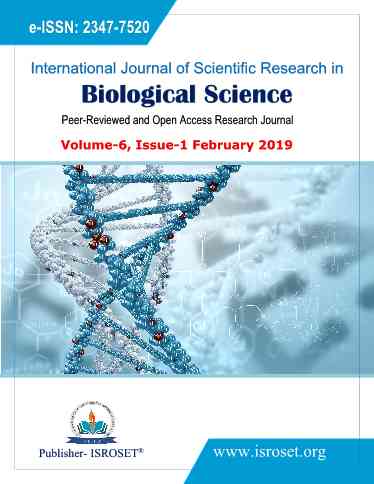The lack of UME6 sustain 2- deoxy-D-glucose toxicity under inositol limitation condition in Saccharomyces cerevisiae
Keywords:
2-deoxy-D-glucose, INO1, β-Galactosidase activity, over production of inositolAbstract
The glucose analogues 2-DG exposure affects glycolytic enzymes. Glucose-6 P is the precursor for the synthesis of myo-inositol metabolism, 2-DG exposer reduced myo-inositol level. In the current study, we found UME6 deletion depict resistance to the 2-DG toxicity. The UME6 deletion increased the INO1 β-galactosidase activity even the exposer of 2-DG in (0.025% and 0.05%) under I− condition compared to WT cells. The sever growth impairment was observed in 0.025% concentration of 2-DG, and also severally affects the INO1 transcription in WT cells under inositol deprivation. The 0.05% concentration highly toxic no growth was observed under inositol limitation, which led to abolish the INO1 transcription in WT cells. The UME6 transcription factor negatively regulates INO1 transcription this could be the reason for the resistance ume6∆ strain of 2-DG toxicity with I− condition. We conclude that the ume6∆ resistant with the exposure of 2-DG under inositol limitation condition in Saccharomyces cerevisiae
References
K.S. Bowdish and A.P. Mitchell, “Bipartite Structure of an Early Meiotic Upstream Activation Sequence from Saccharomyces cerevisiae” Mol Cell Biol. Vol.13, Issue 4, pp 2172–2181, 1993.
J.C. Jackson and J.M. Lopes, “The yeast UME6 gene is required for both negative and positive transcriptional regulation of phospholipid biosynthetic gene expression”. Nucleic Acids Res. Vol 24, Issue.7, pp 1322–1329, 1996.
S.A. Henry, S.D. Kohlwein and G.M. Carman, “Metabolism and regulation of glycerolipids in the yeast Saccharomyces cerevisiae”, Genetics. Vol.190, Issue.2, pp 317–349, 2013.
M.A. Hossain, J.M. Claggett, S.R. Edwards, A. Shi, S.L. Pennebaker, M.Y. Cheng, J. Hasty, T.L. Johnson, “Posttranscriptional Regulation of Gcr1 Expression and Activity Is Crucial for Metabolic Adjustment in Response to Glucose Availability” Mol, Vol.62, Issue. 3, pp 346–358, 2016.
P. Biely, Z. Kratky, J. Kovařík, Š. Bauer, “Effect of 2-Deoxyglucose on cell wall formation in Saccharomyces cerevisiae and its relation to cell growth inhibition”, J Bacteriol, Vol.107, Issue.1, pp 121–129, 1971.
A.N. Wick, D.R. Drury, H.I. Nakada, J.B. Wolfe, “Localization of the primary metabolic block produced by 2-deoxyglucose”, J Biol Chem, Vol.224, Issue.2, pp 963–969, 1957.
W. Chen, M. Gueron, “The inhibition of bovine heart hexokinase by 2-deoxy-Dglucose-6-phosphate: Characterization by 31P NMR and metabolic implications”, Biochimie, Vol. 74, Issue.9-10, pp 867–873, 1992.
G.M. Carman and G.S. Han, “Regulation of phospholipid synthesis in the yeast Saccharomyces cerevisiae”, Annu. Rev. Biochem, Vol.80, pp 859–883, 2011.
S.A. Henry, S.D. Kohlwein and G.M. Carman, “Metabolism and regulation of glycerolipids in the yeast Saccharomyces cerevisiae”, Genetics. Vol.190, Issue.2, pp 317–349, 2013.
C. Ravi, V. Nachiappan, “In Saccharomyces cerevisiae the attenuation of the 2- deoxy-D-glucose toxicity is alleviated by inositol”, International Journal of Scientific Research in Biological Sciences, Vol.5, Issue.6, pp.56-60, 2018.
L.E. Burton, W.W. Wells, “Studies on the effect of 5-thio-d-glucose and 2-deoxy-d-glucose on myo-inositol metabolism”, Archives of Biochemistry and Biophysics, Vol.181, Issue.2, pp 384-392, 1977.
M. Ralser, M.M. Wamelink, E.A. Struys, C. Joppich, S. Krobitsch, C. Jakobs, H. Lehrach, “A catabolic block does not sufficiently explain how 2-deoxy-D-glucose inhibits cell growth”, Proc Natl Acad Sci USA, Vol.105, Issue.46, pp 17807-11, 2008.
M.M. Bradford, “A rapid and sensitive method for the quantitation of microgram quantities of protein utilizing the principle of protein-dye binding”, Anal. Biochem, Vol.72, Issue.1-2, pp 248–254, 1976.
M. Rose and D. Botstein, “Construction and use of gene fusions to lacZ (β- galactosidase) that are expressed in yeast”, Methods Enzymol, Vol.101, pp 167–180, 1983.
Downloads
Published
How to Cite
Issue
Section
License

This work is licensed under a Creative Commons Attribution 4.0 International License.
Authors contributing to this journal agree to publish their articles under the Creative Commons Attribution 4.0 International License, allowing third parties to share their work (copy, distribute, transmit) and to adapt it, under the condition that the authors are given credit and that in the event of reuse or distribution, the terms of this license are made clear.







